The developer team of the Inter-Blockchain Communication (IBC) protocol Cosmos has taken a notable step to reduce the inflation of Cosmos’s native token ATOM. According to a proposal made by StakeLab, which serves as a staking platform in the Cosmos ecosystem, on January 9th, developers want to lower the minimum inflation of ATOM to 0%.
Noteworthy Details Regarding the Vote
ATOM’s current inflation rate is between 7% and 20%, and if the proposal is approved by the DAO, it will be reduced to between 0% and 20%. For the proposal to be accepted, it must achieve a sufficient majority of the current supply of ATOM and receive a yes vote before January 23rd. StakeLabs explained the rationale behind the proposal with the following words:
“This minimum rate theoretically means that even if 100% of the token supply is staked, the network will continue to produce an additional 7% of tokens annually. This situation is causing concerns and, as far as I know, is not compatible with any other functioning blockchain model.”
StakeLab also stated that the community should consider transferring protocol revenue to ATOM stakers from emerging Cosmos ecosystems instead of directly issuing tokens:
“If the revenue from consumer ecosystems becomes significant, maintaining an annual emission rate of 7% may not make sense.”

What Factors Affect ATOM Price?
According to a user on the subject, the 0% inflation proposal could discourage current ATOM stakers and affect the ecosystem’s tokenomics, where more than 60% of ATOM is currently staked:
“For example, two networks based on the Cosmos SDK with 0 inflation are DYDX and Kava. DYDX is still in transition, while Kava has been here for a while but recently applied 0% inflation. Currently, DYDX has about a 7% stake, and Kava has a 12% stake.”
Along with all these developments, recent airdrop events in the Cosmos ecosystem have managed to attract the attention of crypto communities. Especially, investors participating in airdrop events targeted at ATOM stakers can earn significant gains in addition to their staking income. This, in turn, helps to reduce the circulating supply of ATOM and assists in increasing its price.

 Türkçe
Türkçe Español
Español










